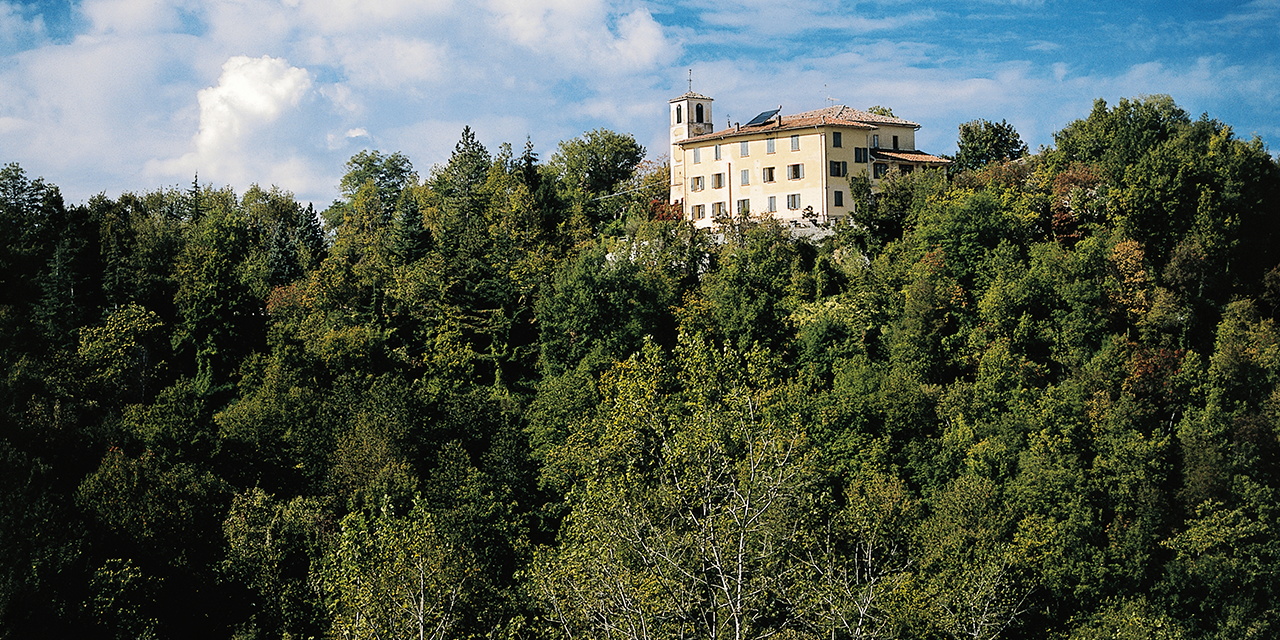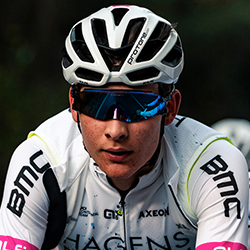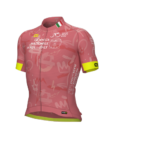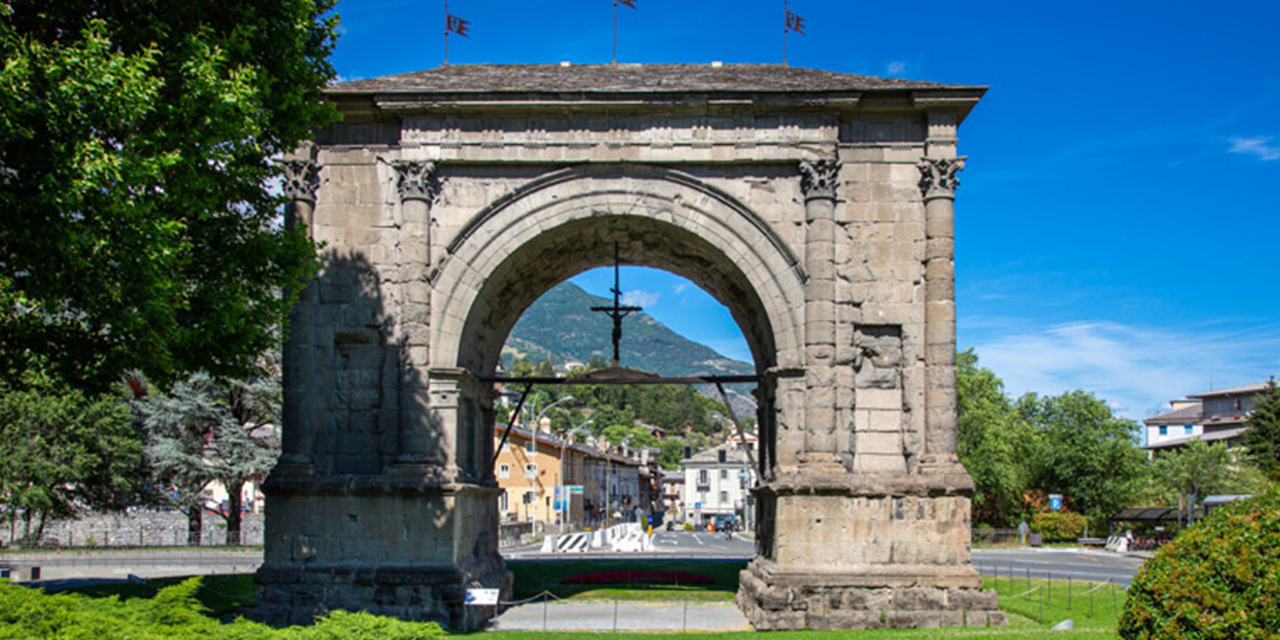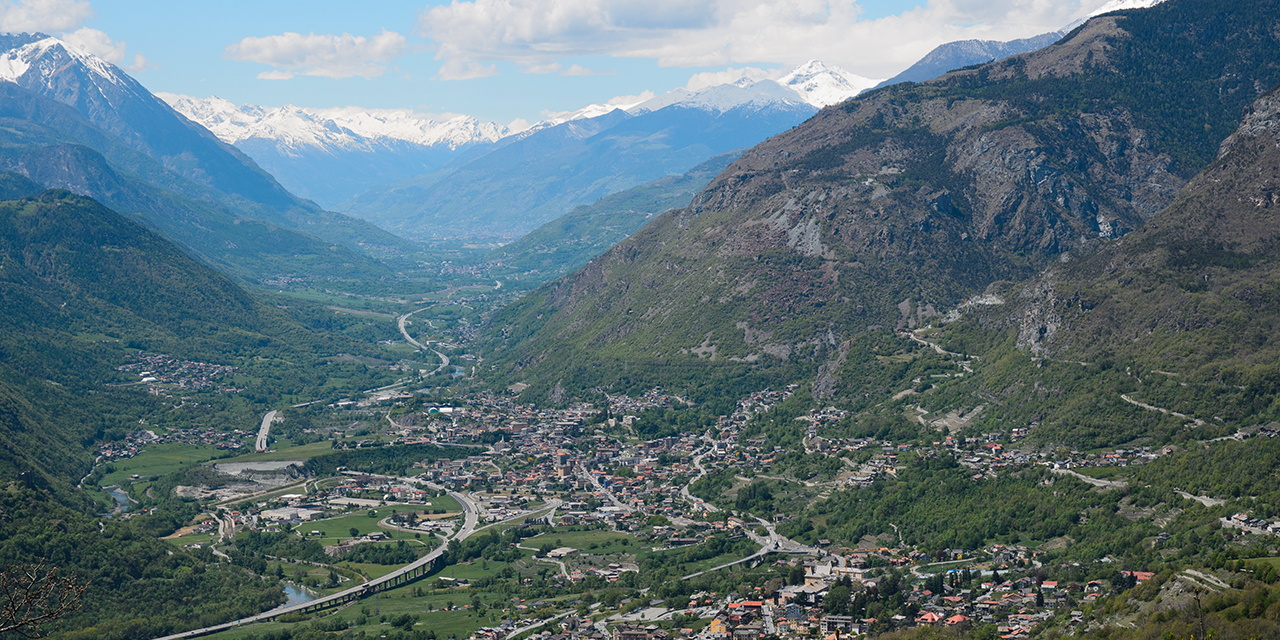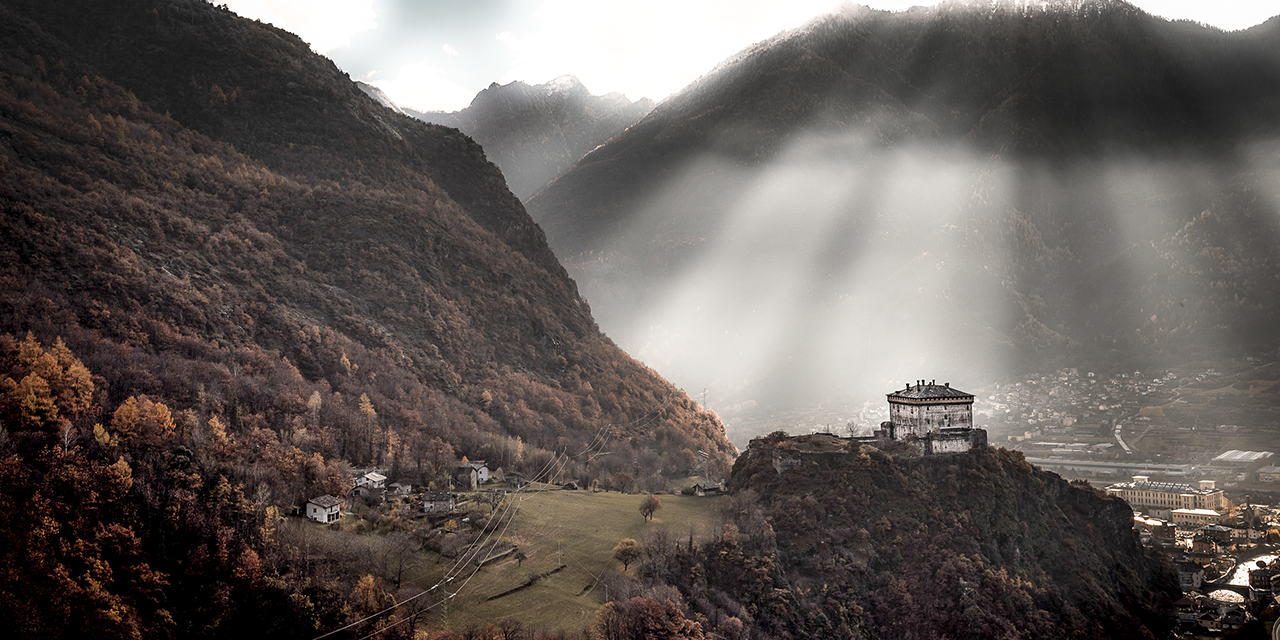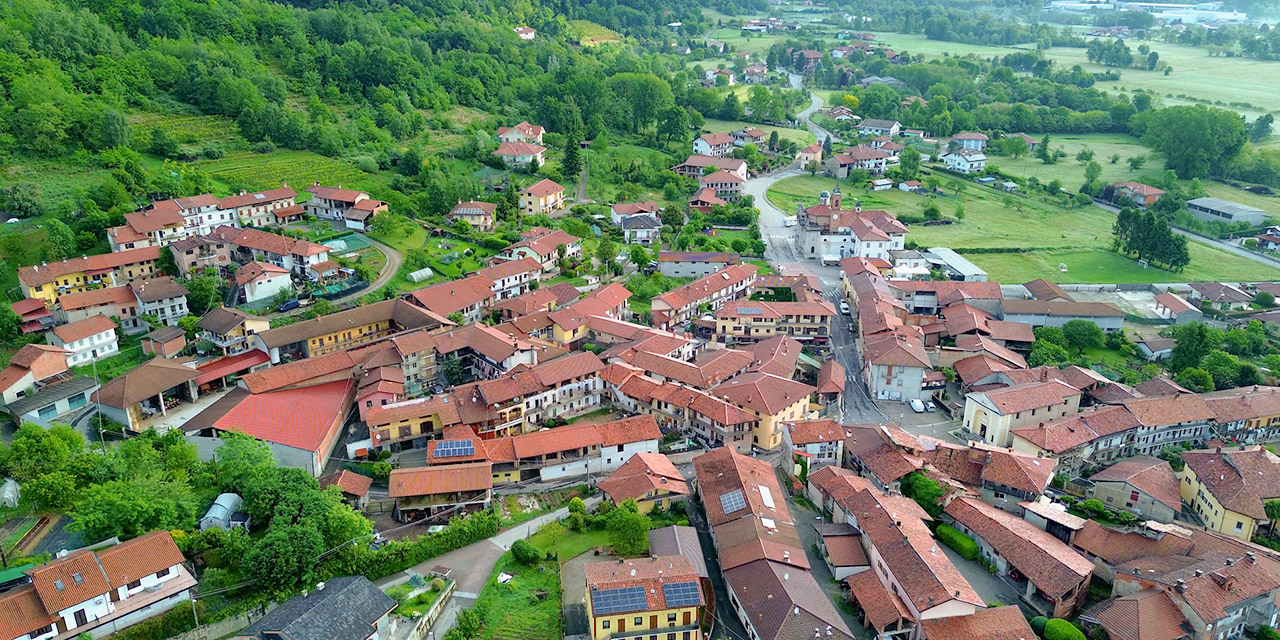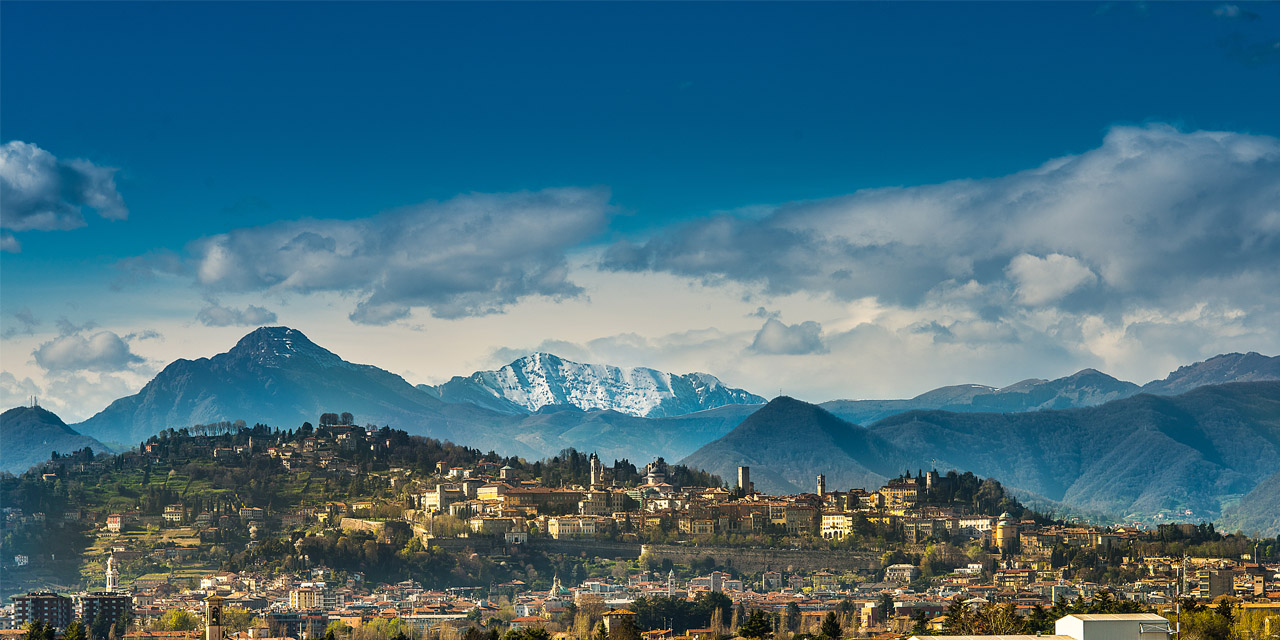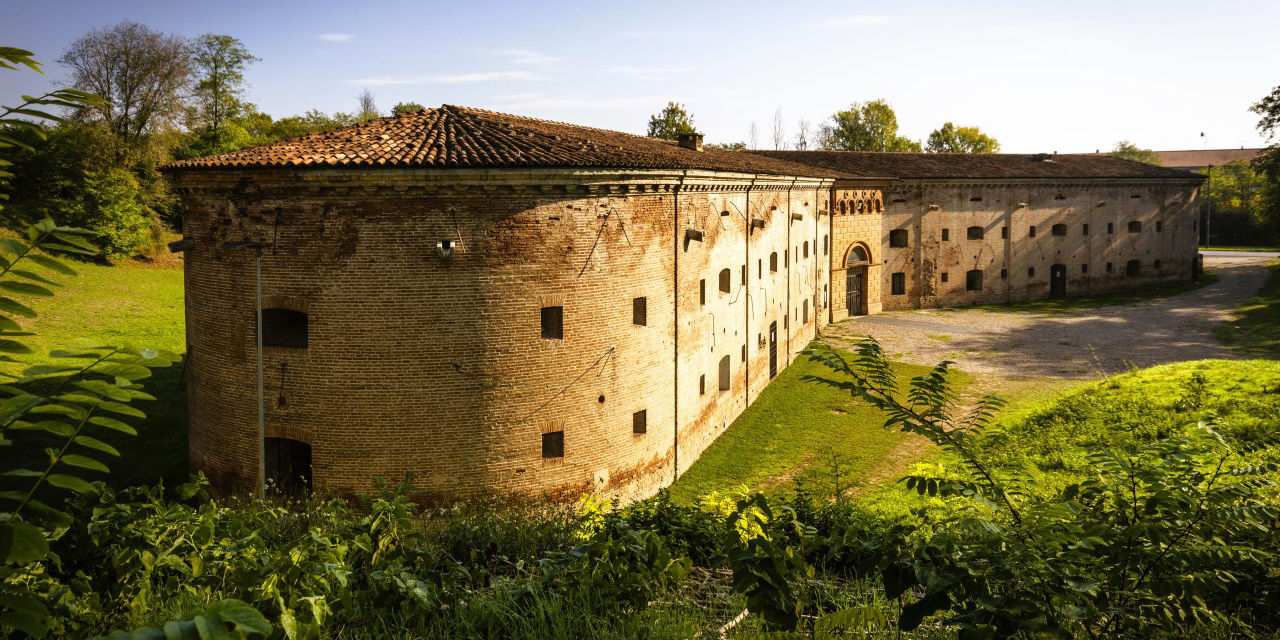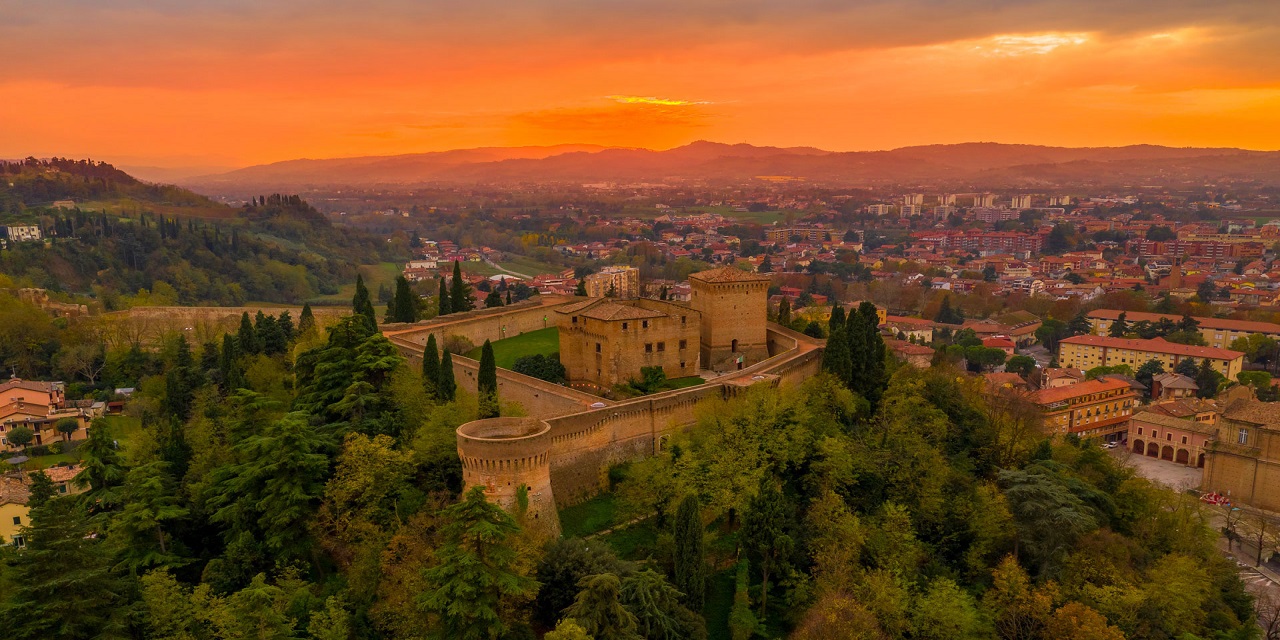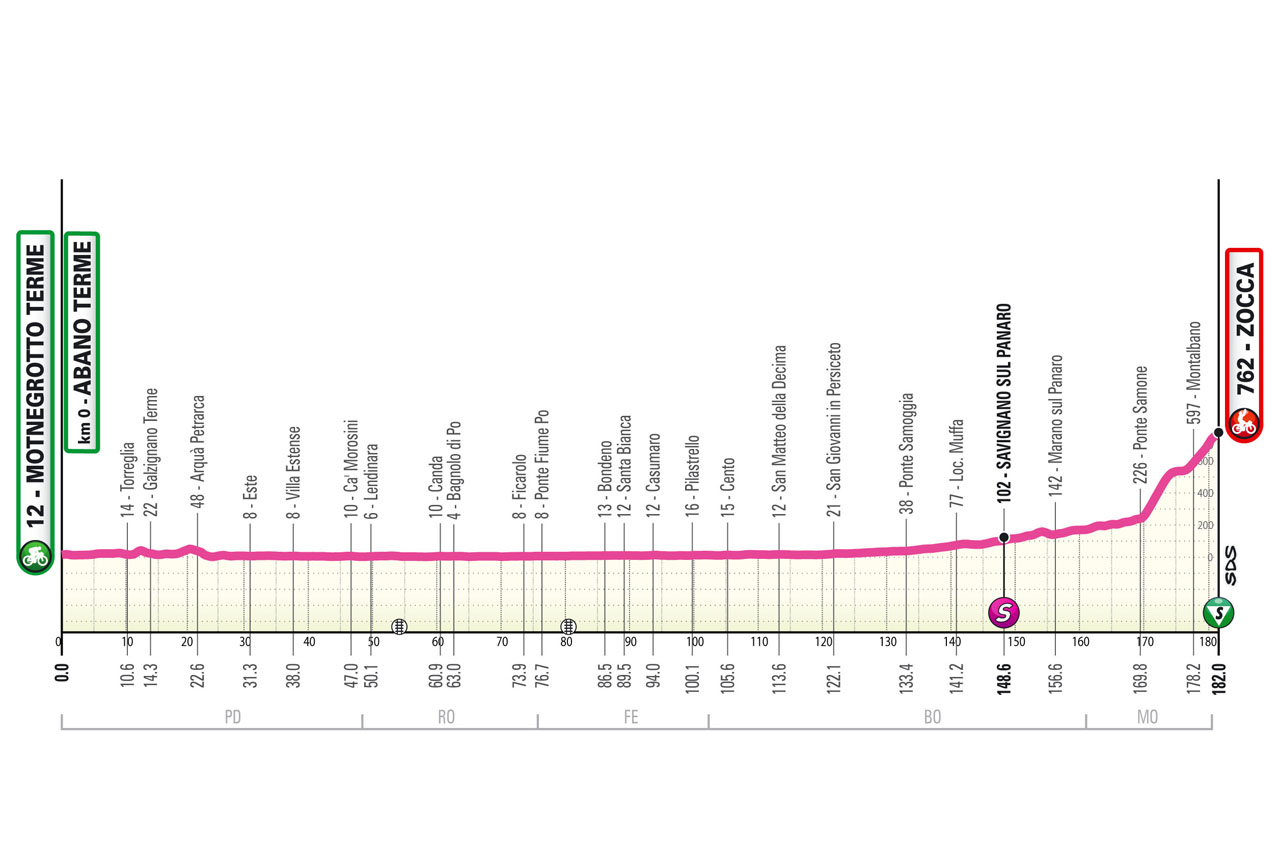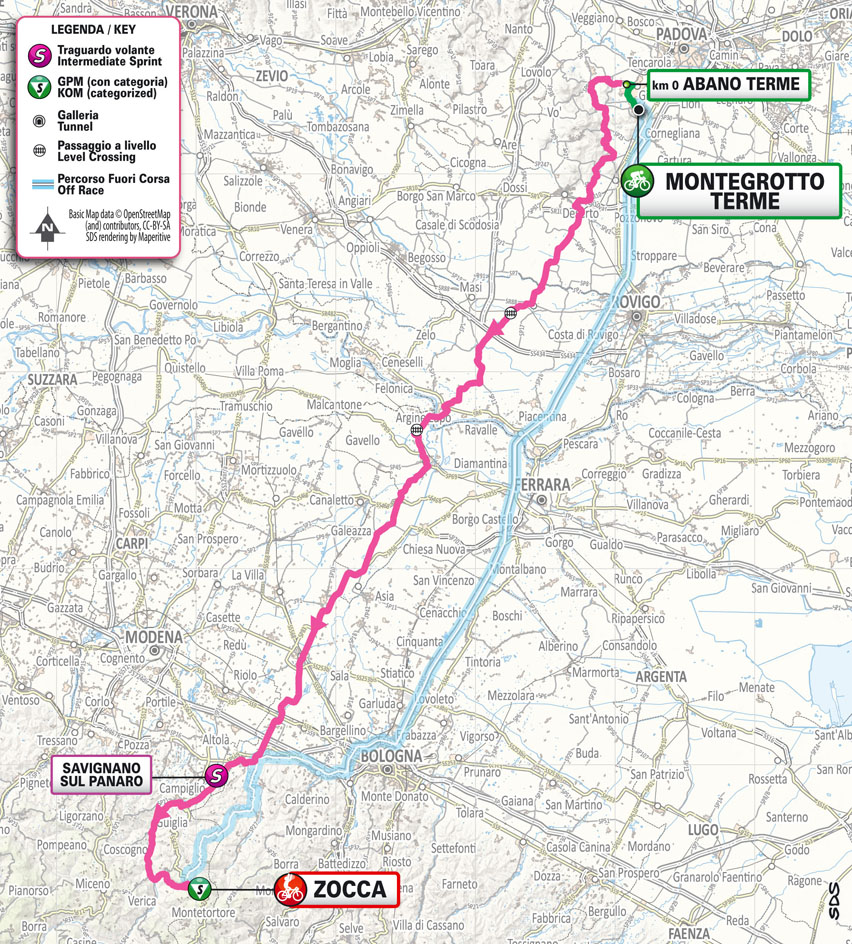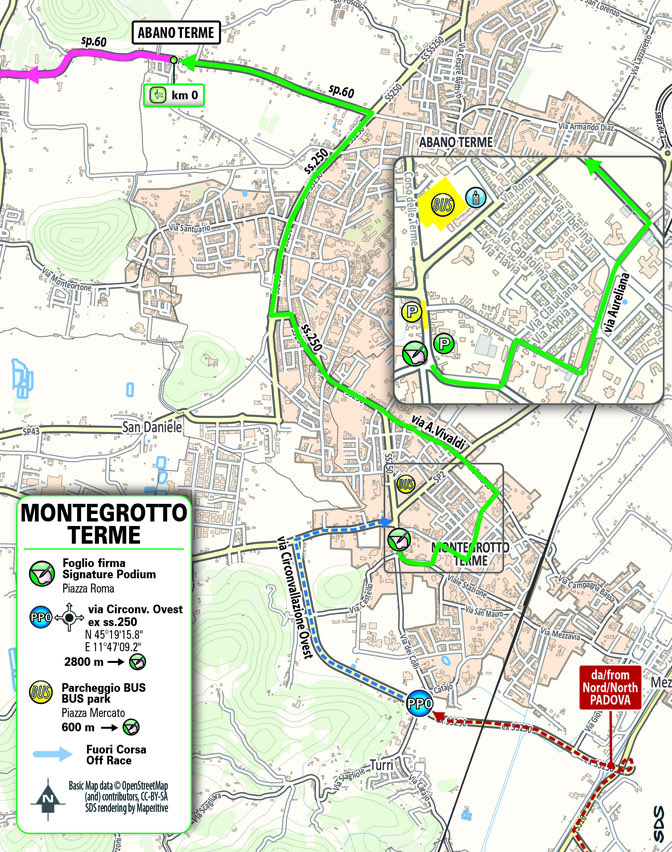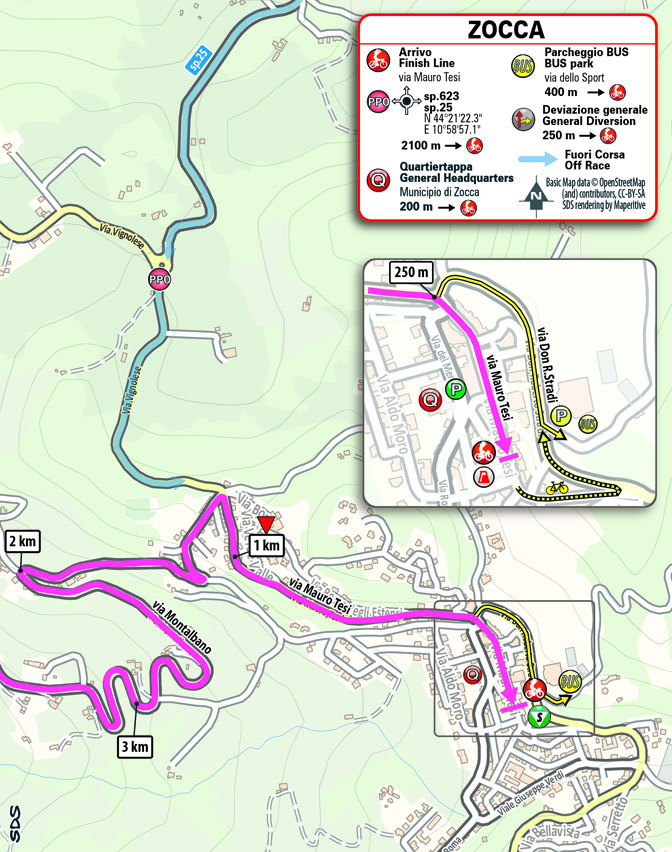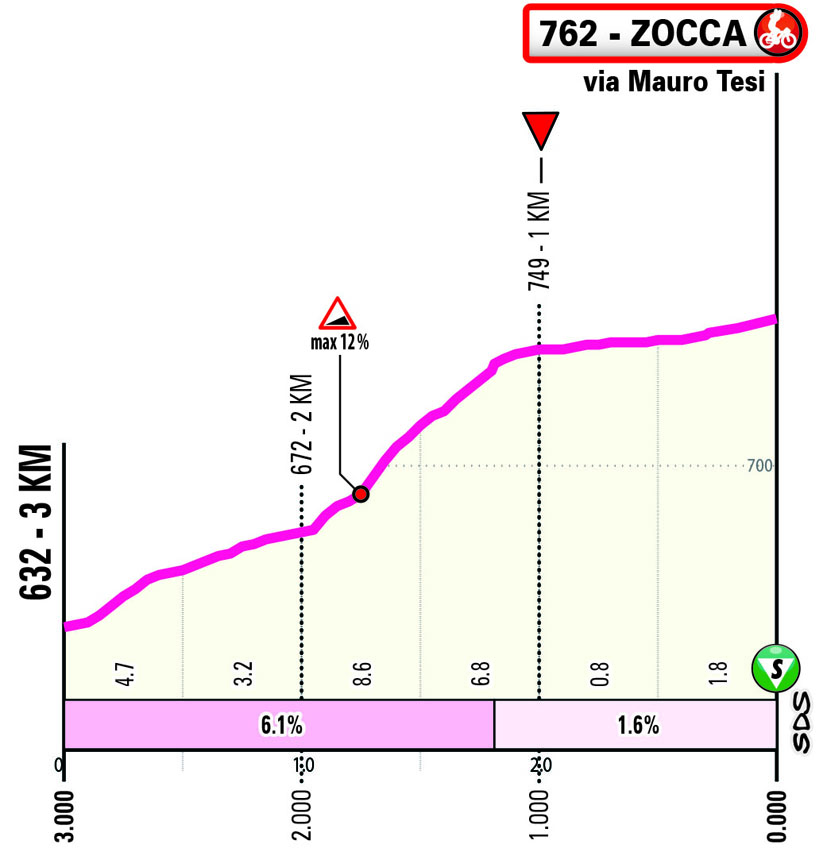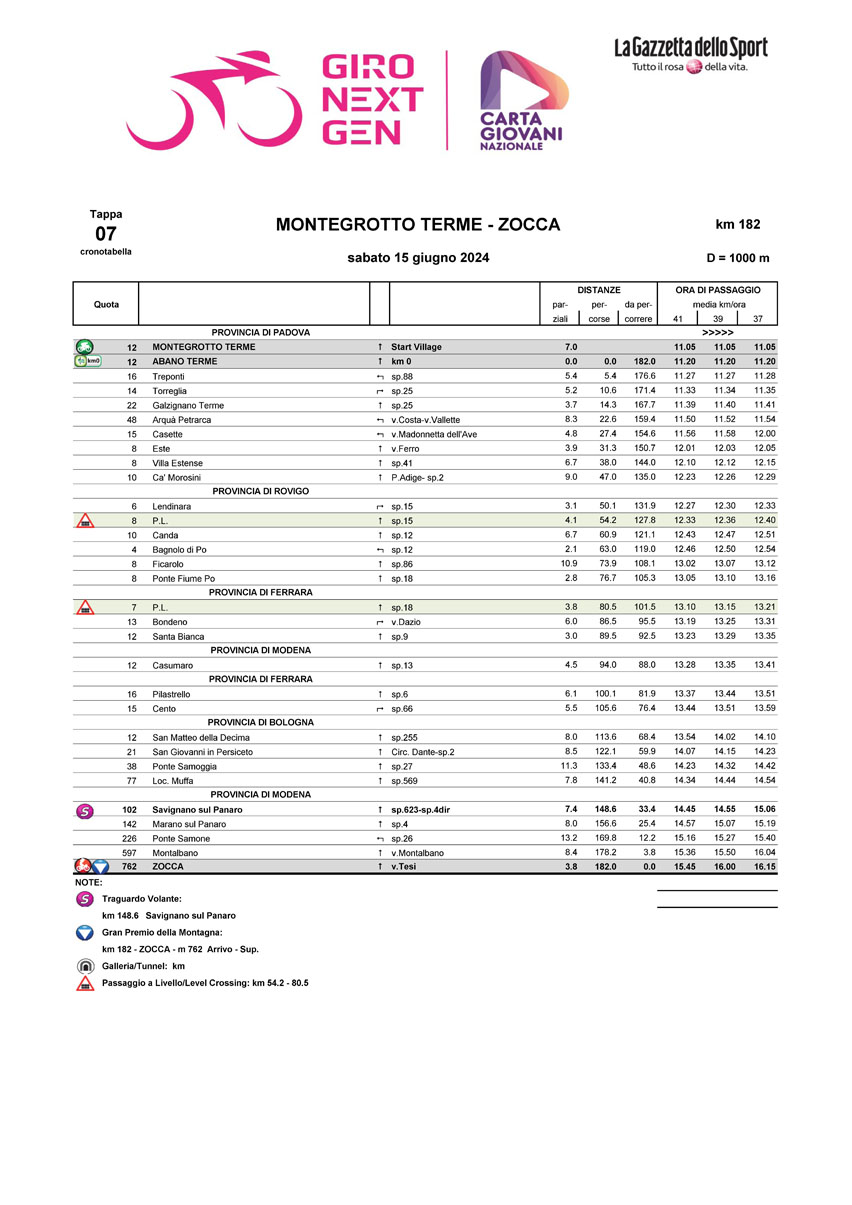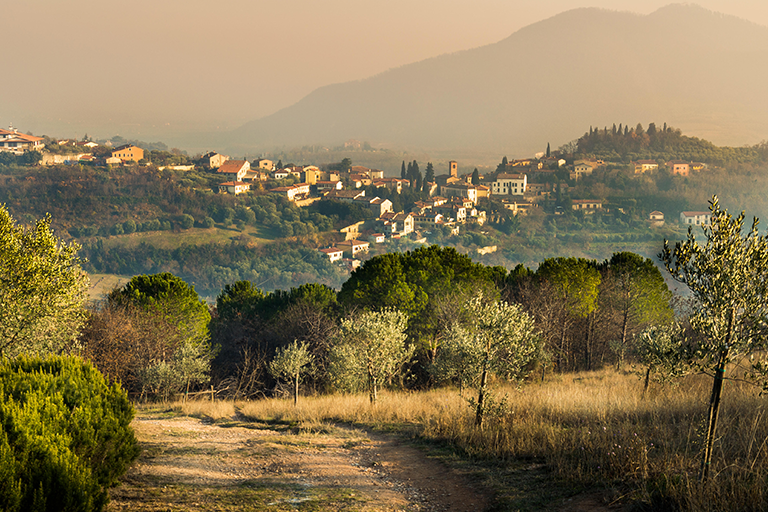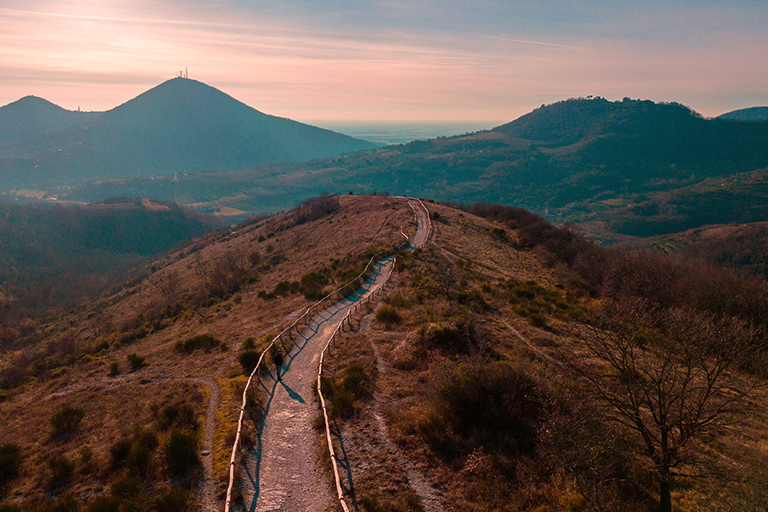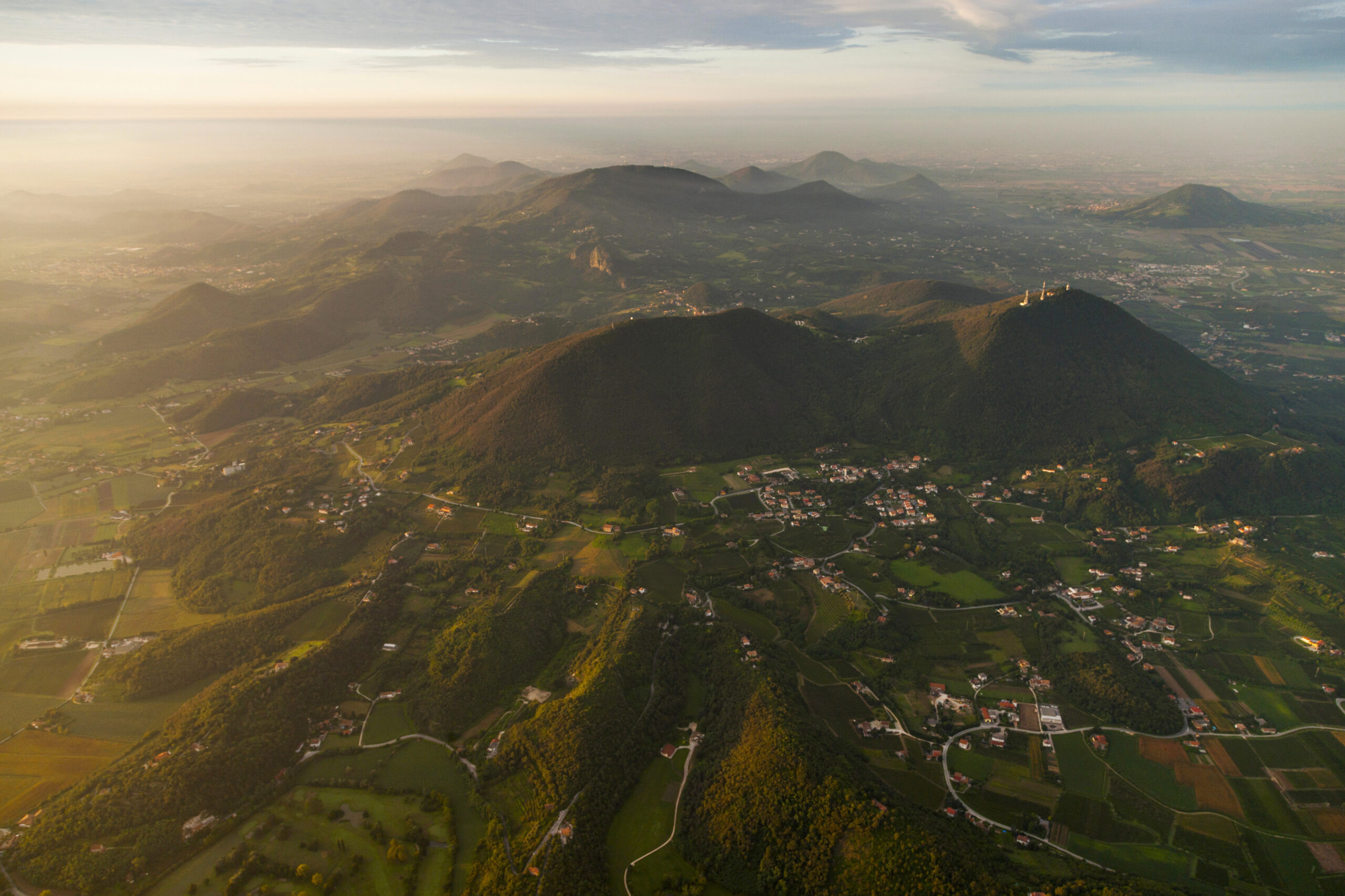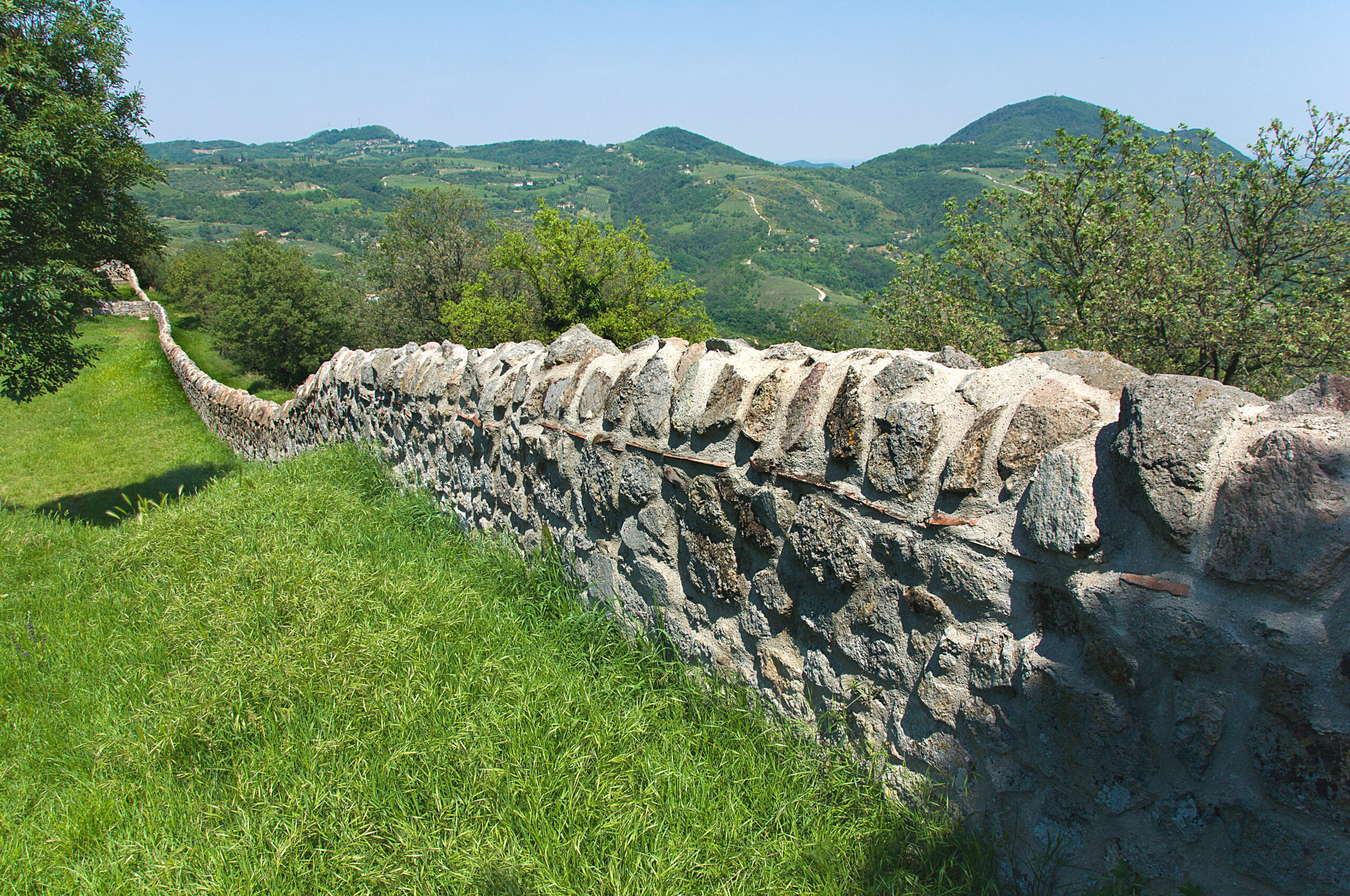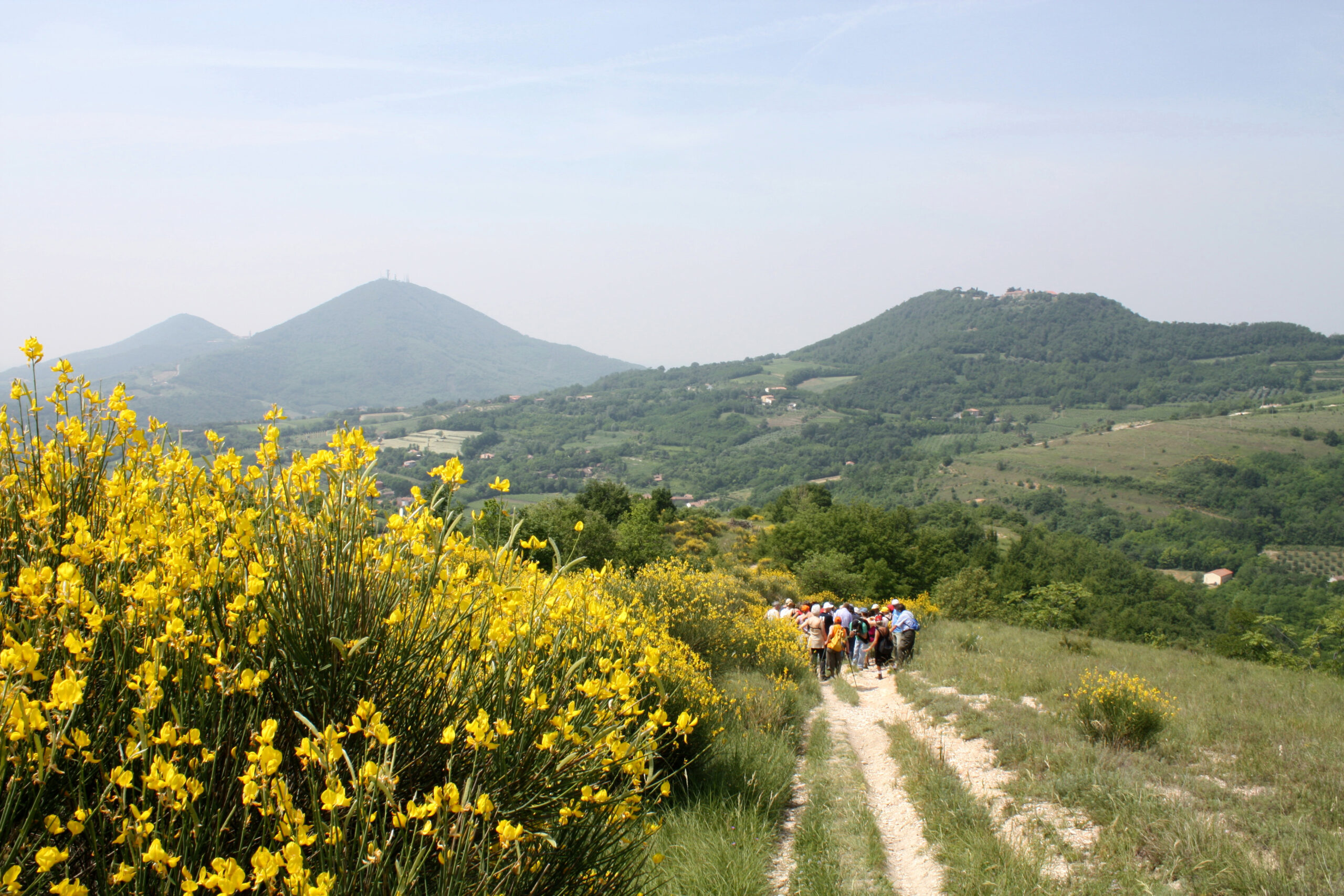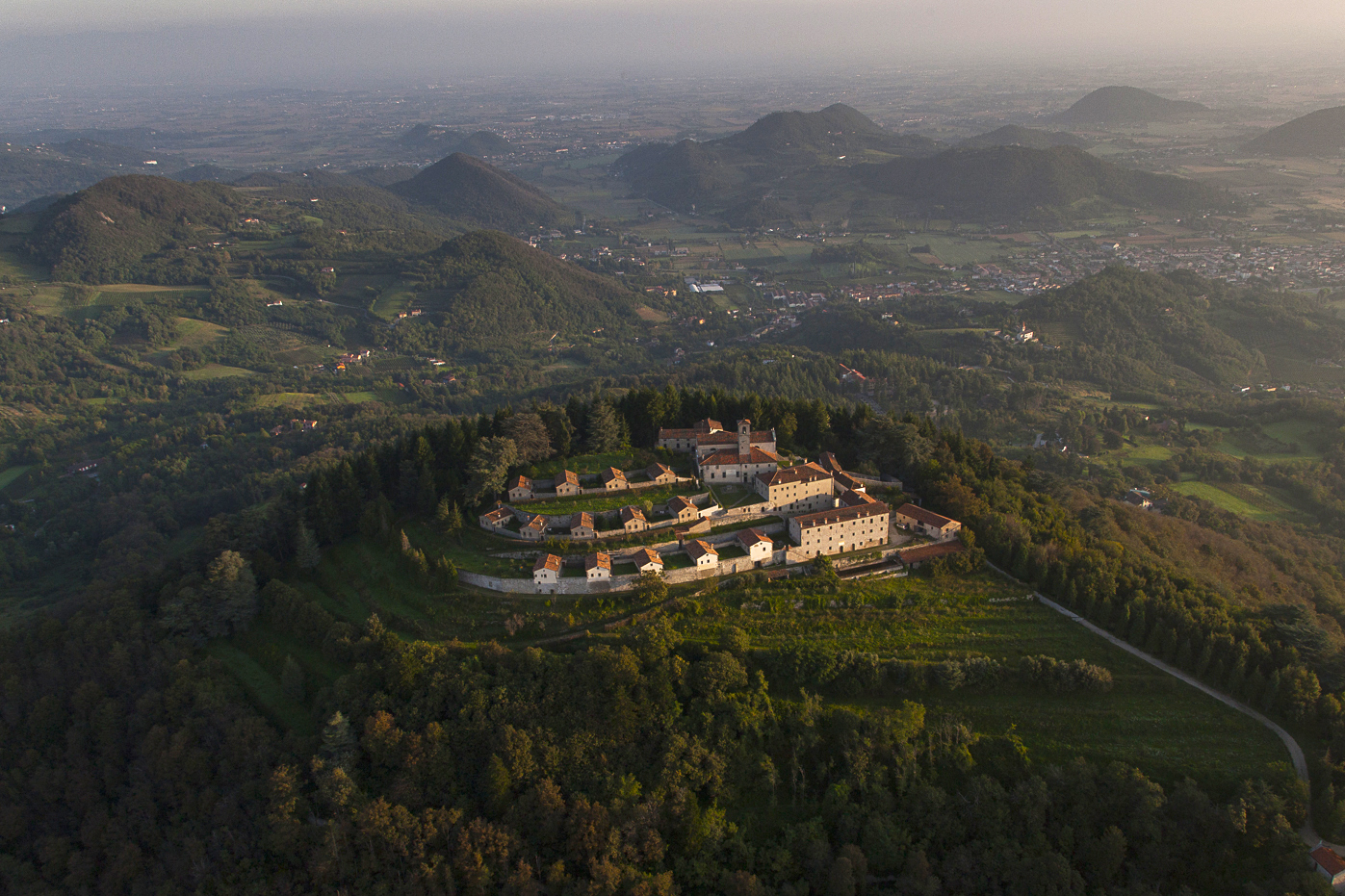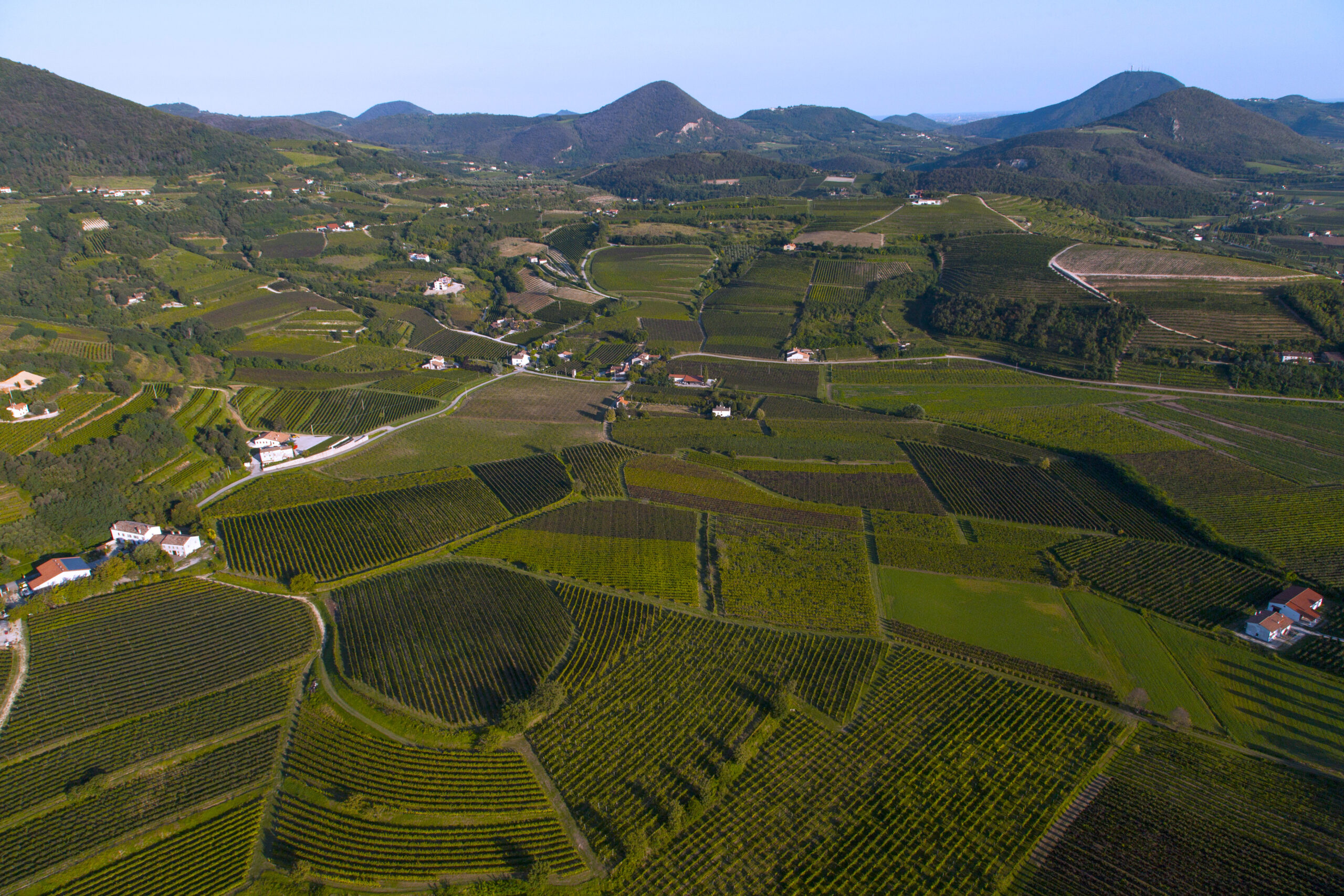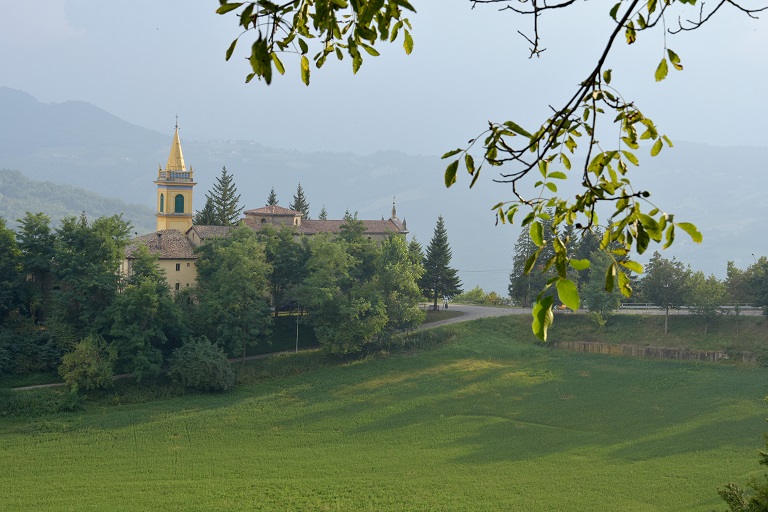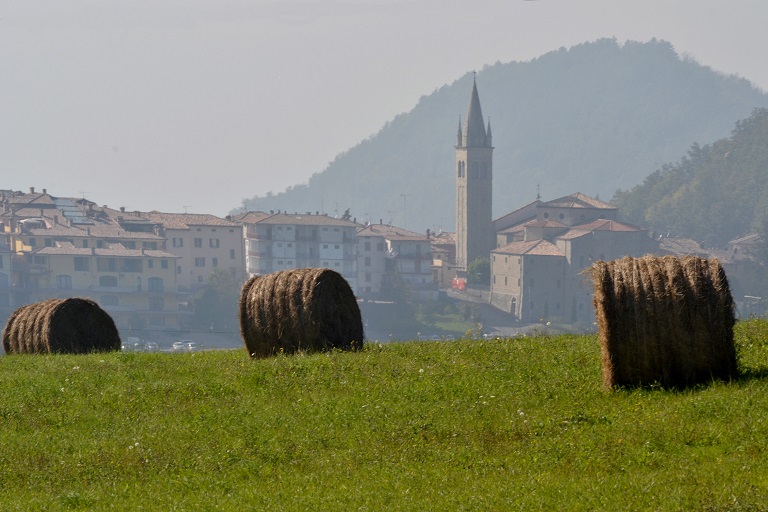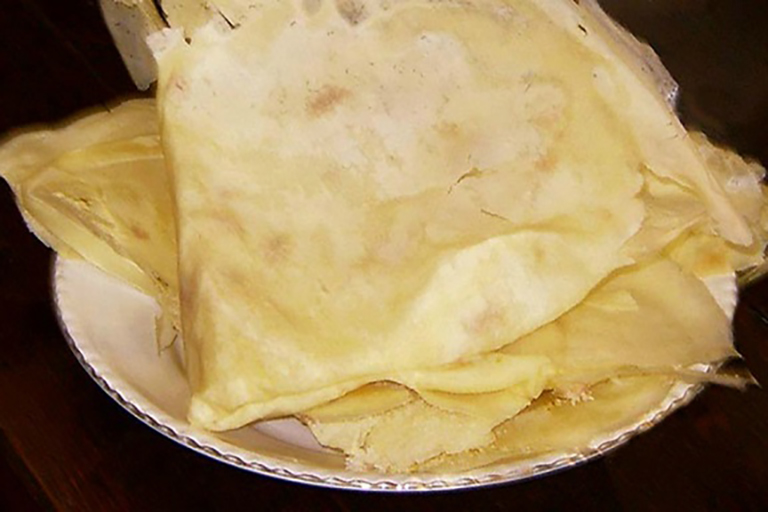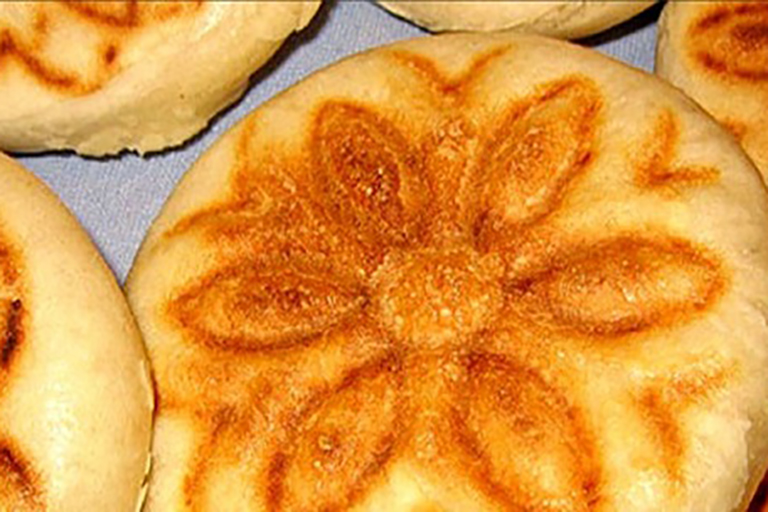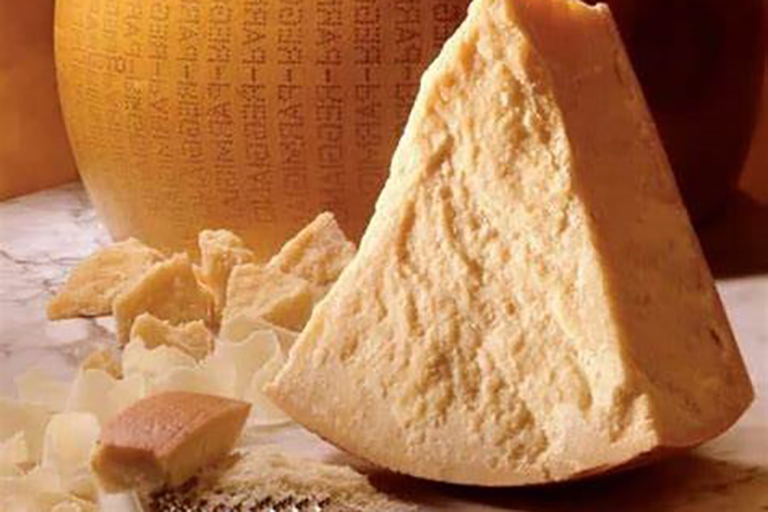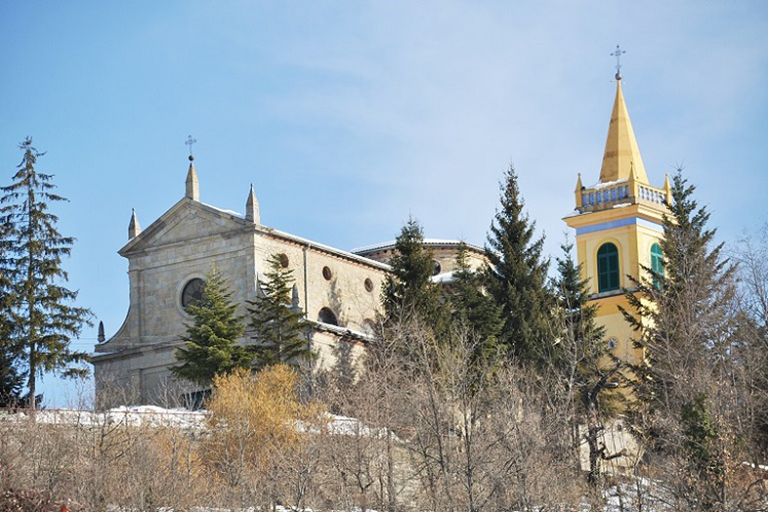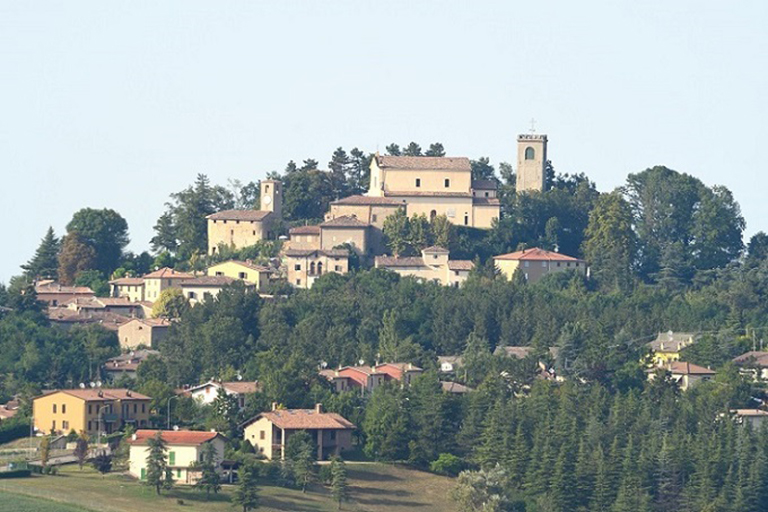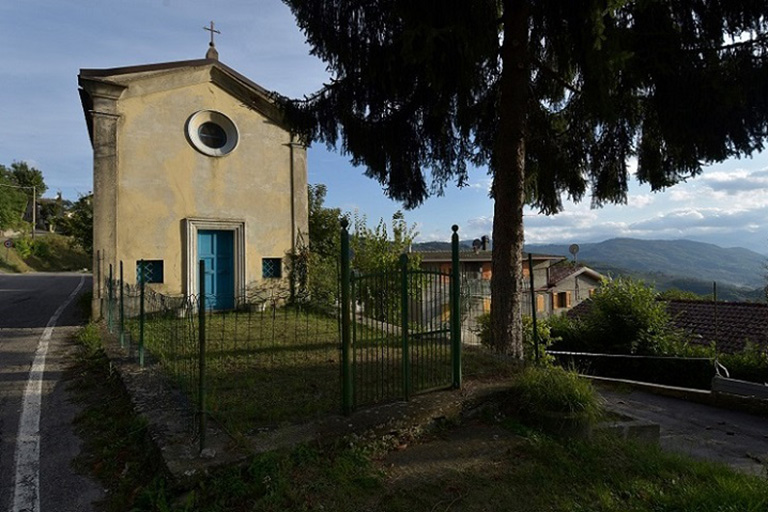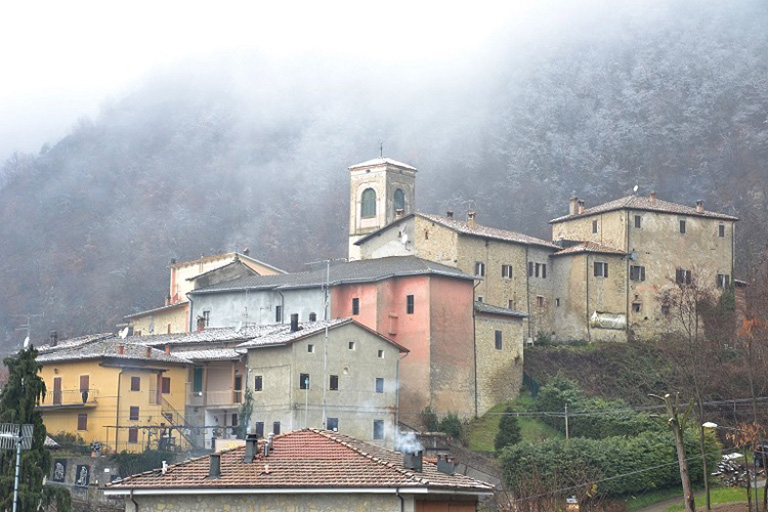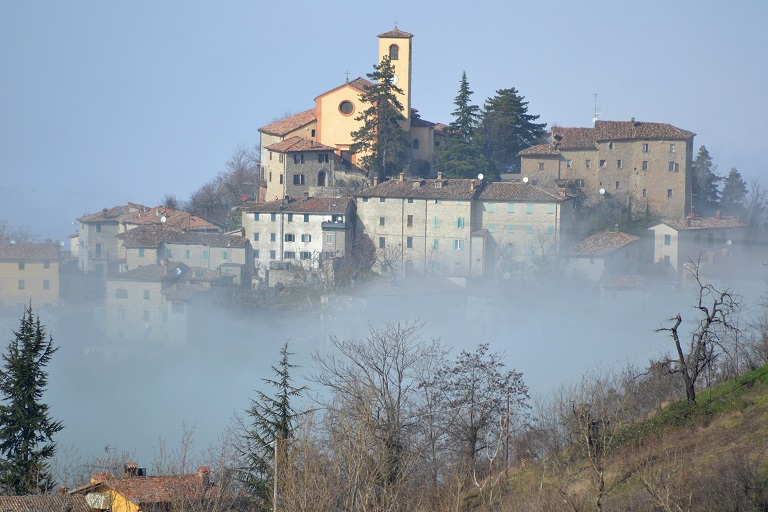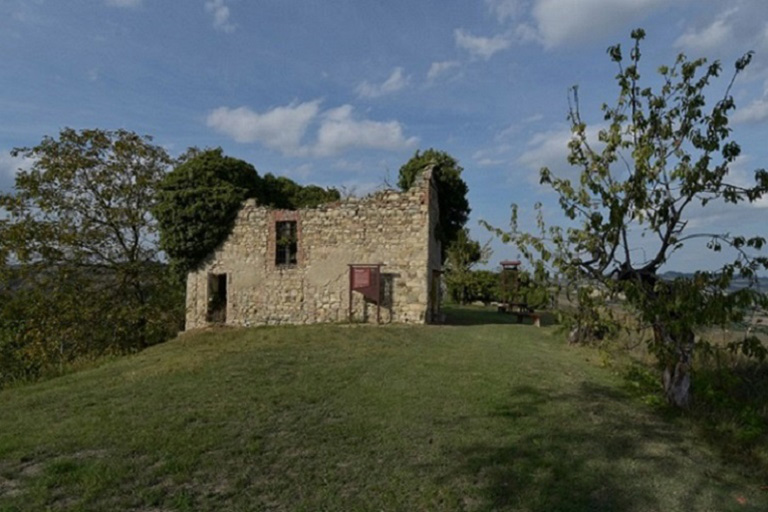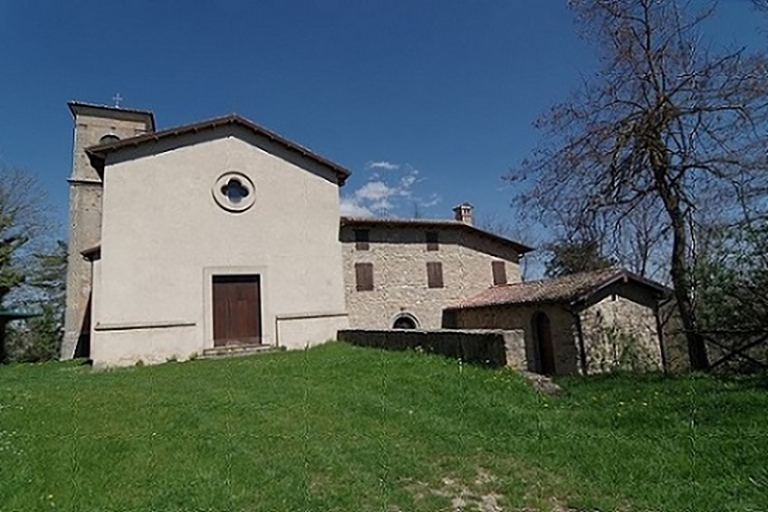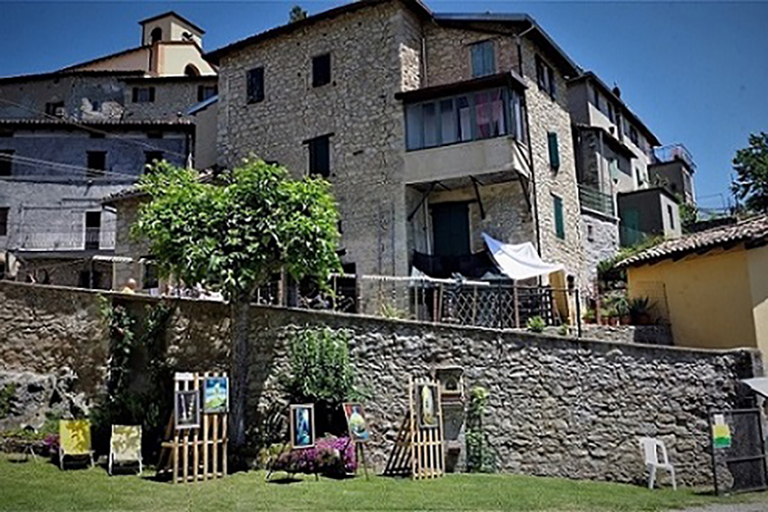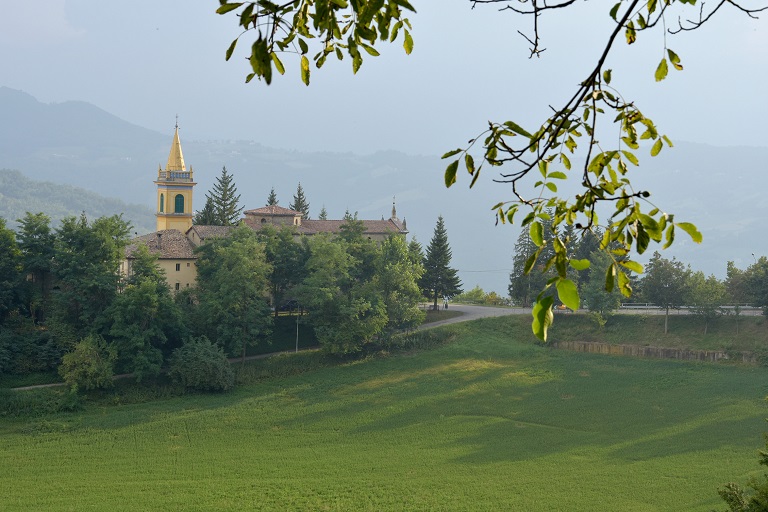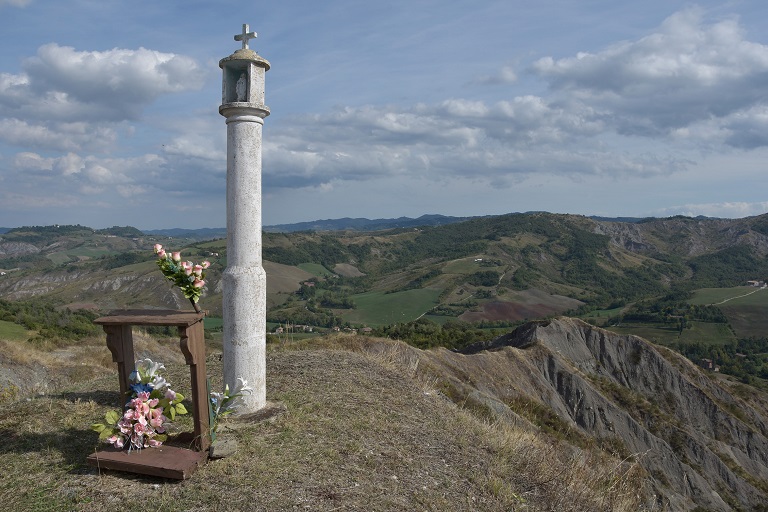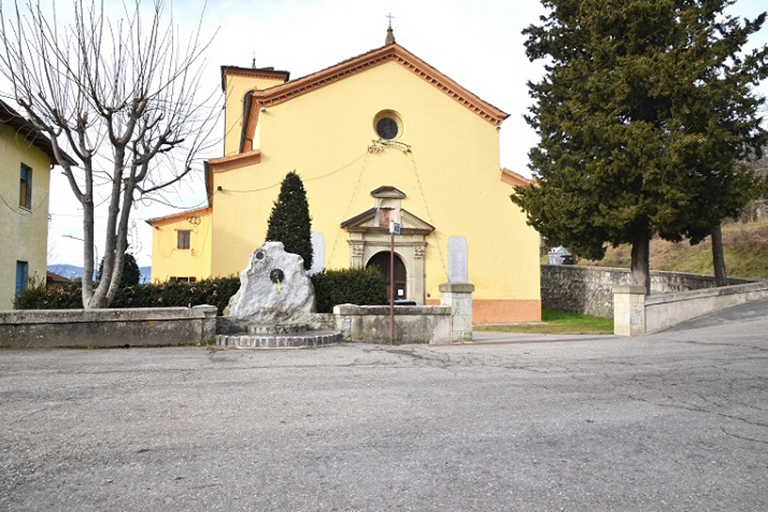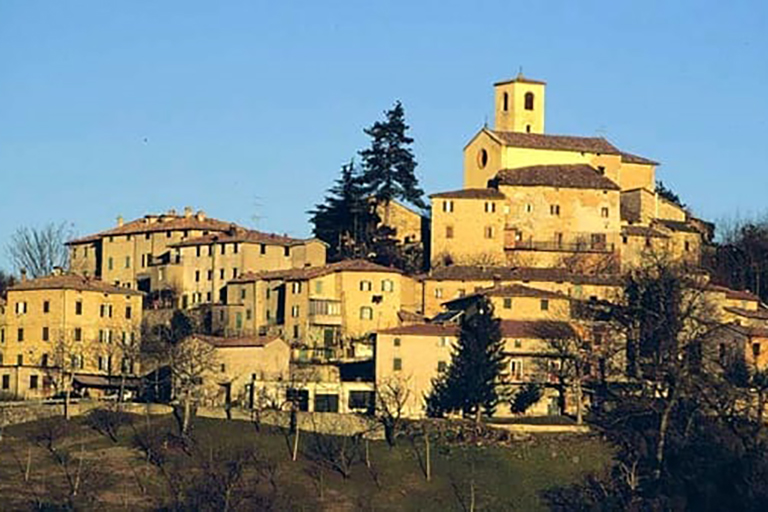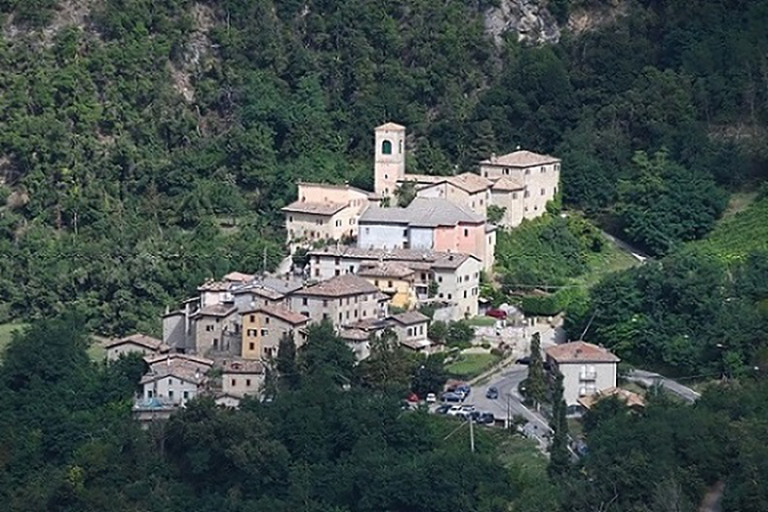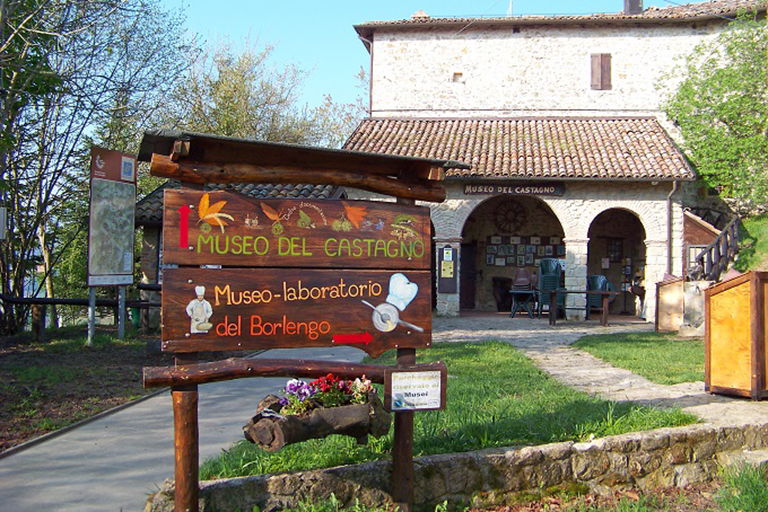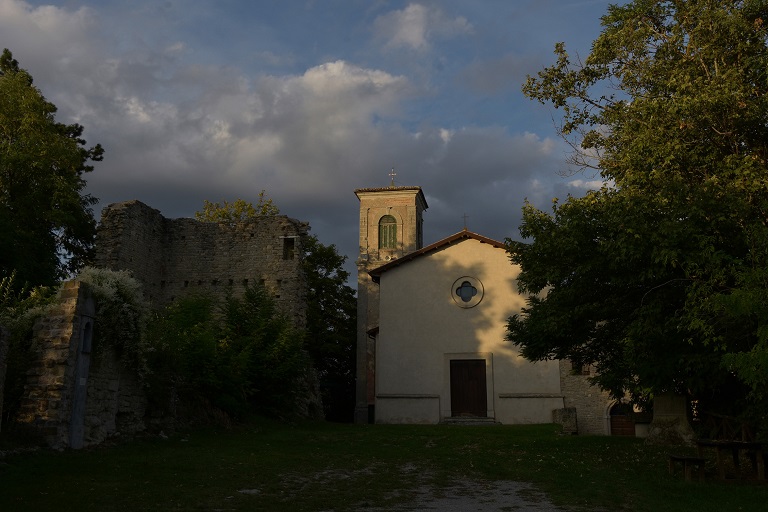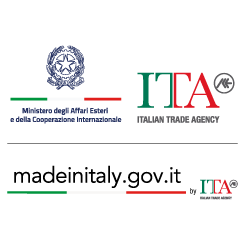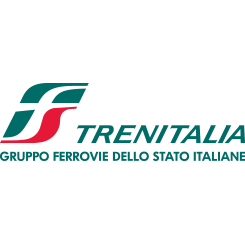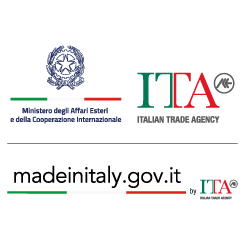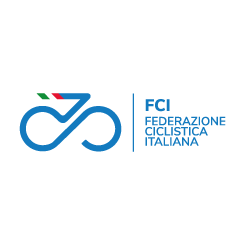learn more
technical info
profile
map
technical info
An entirely flat or slightly uphill stage until the last 12 km leading to Zocca. The route crosses the plains of Veneto and Emilia Romagna on straight roads interspersed with the usual traffic obstructions (roundabouts, traffic dividers, speed bumps, etc.). Final climb with numerous hairpin bends and some very demanding stretches interspersed with false-flat sectors.
Last kilometres
The first two of the final three kilometres are markedly uphill, the last one is flat.
start / finish
final kilometres
itinerary timetable
tourist info
Host city:
Montegrotto Terme
Overview
Montegrotto Terme is a renowned spa town located at the foot of the Euganean Hills, a short distance from Padua. Known since ancient times for its thermal waters, it boasts a rich and fascinating history dating back to Roman times when the spas were already appreciated for their healing properties. The town is famous for its modern and well-equipped thermal facilities that offer wellness, health, and relaxation treatments using mineral-rich volcanic waters. This makes the Venetian town an ideal destination for those seeking rejuvenation and body care, thanks also to the presence of natural mud. Besides the spas, Montegrotto offers numerous points of interest: from the historical and archaeological heritage, with sites such as the Museum of Ancient Thermalism and the Archaeological Park of Viale Stazione, to Villa Draghi, an example of eclectic architecture close to the oriental and lagoon Gothic style, surrounded by a centuries-old park with manicured gardens and enchanted statues, to the natural beauties of the Regional Park of the Euganean Hills, perfect for hikes and walks. The town also boasts the Museum of Thermalism, which preserves artifacts from the archaeological areas of Montegrotto Terme, and the Butterfly Arc, where all stages of development of over 400 butterflies, both diurnal and nocturnal species, can be studied. The recent avant-garde construction Y-40 The Deep Joy, the world’s deepest thermal water pool, contains 4300 cubic meters of water at a temperature of 32-34°C, allowing immersion without the need for a wetsuit.
Food
The goal of the Park Authority is always to enhance the true riches of the territory such as oil, wine, typical products, and culinary specialties, creating new synergies between society, businesses, and the world of culture with the participation of citizens. The charm of a unique landscape and the exceptional natural environments that promote biodiversity combine with the local food and wine excellences, offering numerous guests a unique experience that brings together an extraordinary sensory whole of nature, landscape, culture, tradition, history, and taste. The land’s products, skillfully transformed by masters of the sector who, from generation to generation, pass down and refine this art with passion, become traditional Venetian culinary specialties that can be enjoyed in the numerous restaurants, trattorias, farmhouses, and wineries of the territory. Our cuisine also aspires to be increasingly sustainable, especially now, when the Regional Park of the Euganean Hills is officially a candidate to become a UNESCO MAB Biosphere Reserve, an important recognition that will allow the Euganean Hills to join a global network where there will also be the opportunity to promote and enhance the excellences of our territory, including our food and wine tradition.
Wines and Beverage
The presence of the vine in the Euganean Hills is very ancient and today Euganean viticulture is a rapidly growing sector, with small and medium-sized wineries that combine modern technology and ancient knowledge to offer a product that, whether fresh and young or aged in barriques, always presents with a distinctive personality of aromas and colors. In each bottle, we can thus find the work, stories of people, and the voices of the seasons. The Denomination of Controlled Origin “Colli Euganei” was recognized by the Presidential Decree of August 13, 1969, and on December 22, 2010, the Ministerial Decree recognizing the DOCG for Fior d’Arancio was published. The Consorzio di Tutela Vini Colli Euganei is a reference point to produce the namesake DOCG and DOC and carries out promotion and monitoring activities for over 200 members (including grape producers and bottlers). The Euganean Hills are primarily identified with Moscati, the yellow called Fior d’Arancio and the whitelisted in the DOC under the generic name of Moscato. The Fior d’Arancio Colli Euganei DOCG is unique worldwide, available in three versions: dry, sparkling, and passito. Moscato, which has always characterized Euganean viticulture, produces grapes vinified both in purity and in blend. This grape has found in the Euganean Hills a habitat so congenial that it offers high-quality products, with impressive aromatic spectra, both for the classic sweet versions and for the new dry vinifications. The other soul of the Euganean Hills is represented by red wines based on Merlot, Cabernet Sauvignon, and Carmenere. The latter rare grape variety, of French origin, in the Colli Euganei Rosso gives intense notes of green pepper, which strongly characterize the Euganean cuvée. The final feature to include in the identity card of these hills is Serprino, an indigenous grape variety, vinified sparkling or semi-sparkling, which gives a white wine with spring aromas. The other types listed in the specification have been mainly included as improving varieties to produce cuvées.
Trails
The Regional Park of the Euganean Hills is crisscrossed by over 30 trails that traverse breathtaking landscapes. The tranquil plains and rugged hills offer an experience suitable for every type of visitor: the levels range from easy paths accessible to all, to more challenging ones aimed at experts. The park’s biodiversity, with its rich variety of flora and fauna, is revealed along every route, offering a natural spectacle that enchants and inspires hikers. The 200 km long natural labyrinth, which winds through lush forests, golden vineyards, and ancient villages, boasts 26 georeferenced trails promoted by the Park Authority, suitable for various outdoor activities, from simple rejuvenating walks to more challenging hikes, ensuring unforgettable experiences for anyone who loves immersing themselves in nature. Among the most scenic is the one leading to Monte Venda, the highest point of the hill chain. From the summit, at an altitude of 601 meters, the view encompasses a breathtaking panorama, stretching from the valleys below to the peaks of the Alps. For those who love history and culture, the Euganean Hills trails also offer the opportunity to visit ancient monasteries, castles, and Venetian villas nestled in the greenery. Key stops include the Praglia Abbey, founded in the 12th century and still a place of prayer and study for Benedictine monks. In such a rich biodiversity area, with extraordinary flora and fauna, chestnut, oak, and beech forests offer refuge to numerous animal species, while cultivated areas host thriving vineyards. The trails are accessible to all, thanks to a wide network of signage and the presence of equipped areas, and can also be visited by bicycle, selecting the appropriate means depending on the trail characteristics: the pride of the area is the 63 km long Euganean Hills E2 cycle ring, which entirely surrounds the Park. In every season, the Euganean Hills offer different emotions, from the warm colors of autumn to the bright green of spring, through the silent charm of winter snow and the freshness of summer forests. Each visit is an opportunity to rediscover the beauty and harmony of nature, allowing oneself to be captivated by the scents, sounds, and sensations that only these magical places, candidates for UNESCO recognition, can offer.
Zocca
Overview
Zocca is an important town of the Tuscan-Emilian Apennines. It actually straddles the crest that divides the Panaro valley from those of Reno and Samoggia; an exceptional position, which gives the town a particular “fine air” which, especially in summer, offers certain relief from the sultriness of the city.
History, tradition, nature and food are the main keywords: In the 70sq km area you will find 7 old villages full of history and beautiful monuments; some from the middle ages and some even older, there are churches, tower bells and rural typical areas. Nature offers beautiful discoveries: the territory is surrounded by trees, so you can relax just walking through our big woods and parks, then you can have a break in an hamlet or visit a farm where very excellent products such as parmigiano-reggiano or chestnuts are grown. You can appreciate very exclusive food such as borlenghi, tigelle and ciacci, moreover there is a wide selection of food made of chestnut fl our such as: casta-gnacci, mistocche, polenta.
Food
BORLENGO
The oral tradition says that it is a kind of carnival food, cooked from Epiphany to Shrove Tuesday; the term “borlengo” probably originates from “Joke” (“burla”). Once the borlengo was cooked on burning sticks in the fireplace, today special cookers called “fires” are hand made and are built as to make the heat radiation to the whole pan uniform. First of all, you need to prepare the “colla” that is a very liquid batter made of flour, water and salt. The pan must be heated to the right point to allow the “catch” of the batter; after that, you must pour a ladle of batter into the pan, then shake the pan so that the batter is evenly spread on the bottom of the container. When the borlengo hardens and raises, it must be turned upside down… and then flavoured with the condiment and a handful of Parmesan cheese. The borlengo must finally be folded in four and served warm.
CIACIO
Together with crescentine, tigelle and borlenghi, this particular kind of bread can be considered one of the “poorer” dishes of our territory’s rural culture. This type of unleavened bread, a relation to the “piadina romagnola”, is prepared with either white fl our (salty ciacio) or chestnut fl our (sweet ciacio). Its name is of tuscan origin; salty ciacio can be filled in the same way as crescentine and tigelle: a mix of minced lard or bacon seasoned with rosemary and garlic and with sliced meats. Sweet ciacio must be fi lled with very good ricotta cheese. And a further touch of refinement can be brought by adding a little chestnut honey and some minced walnut kernels.
MARRONE DI ZOCCA
It has a fruit of elipticaland, regular shape, reddish-brown coloured, with dark streaks, thick and prominent. One kilogram is formed by 70-80 fruits on average; the harvest begins at the end of the fi rst decade of october. The production, of high worth, is destined to the immediate consumption almost esclusively.
Points of Interest
MONTETORTORE
Montetortore is a historical place. On the mountain, straddling the provinces of Modena and Bologna you can find the imposing ruins of the twelfth century castle which for centuries was the real “capital” of the mountains between the Samoggia and Panaro Rivers. As well as the ruins of the castle and the church, the village of Dragodena is worth a visit, situated at the foot of Montetortore, on the side that slopes down towards the Samoggia River. Other very intersting places are Monte San Giacomo, an ancient hostel that currently holds the Chestnut Musem, the fifteenth place Fontana and those of Usignolo (XVI century), the oratory of San Rocco and the convent of Braglie. The Chestnut and Borlengo Museum contains the tools used to care for the chestnut grove and process the products, as well as the Fantacastagneto, used to reconstruct the habitat of the chestnut grove.
MONTOMBRARO
With its swimming pool, the village that clings to the top of the hill where an imposing castle once stood and its lively old town centre, Montombraro is the most important village of the town of Zocca. Montombraro is also a place of culture and refl ection. A pleasant surprise that begins with the splendid seventeenth century church and continues with the community of Cistercian nuns, who open their convent to whoever wishes to spend a few days praying and meditating.
MONTECORONE
One of the most charming and well preserved hamlets of the Tuscan-Emilian Apennines. The ochre bell tower stands on the mountain, surrounded by houses and looks out over the valley below. At one time, the castle belonging to the Contrari family stood here. You can feel the medieval history in the air and in the village alleyways. Montecorone is also nature. The small valley that the village stands in is dominated by the imposing rock face of the Sasso di S. Andrea. Nearby you can also fi nd the Bosco delle Tane woods, with several caves and a very interesting canyon.
CIANO
Ciano, known as Ciliano in ancient times, is mentioned for the first time in 934. In the twelfth century it obeyed its valvassors who were subject to the Sovereignty of Modena’s Town Council, who had it fortified. The church of San Lorenzo dates back to the early 900s, its recently restored organ is magnificent. The rural residential area is of great interest, with its eighteenth century oratory, known as “I Boschi” and the ruins of the castle walls and an oratory in the Castellaccio area.
MISSANO
Missano is an historical place, one of the most ancient village in the area, maybe dating at byzantines domination. The residential area is very intersting: there are many ancients houses with towers, an seventeenth century court named Cà Marinelli, the Oratory of Sant’Agostino and those of Annunciazione and Montevecchio or “of Riva”. Not to be missed is the Church of SS. Vitale e Biagio, with its batipstery. The Monte della Riva, with a maximum height of 808 m. above sea-level, is a ridge stretching from East to West and dominating the high valley of the river Panaro.
MONTALBANO
Montalbano has always been the village of the “terra pendente”, or sloping lands. Perhaps because the houses in the old hamlet climb almost vertically along the southern slope of Monte della Riva. Montalbano has maintained the charm of an old fort, with its steep, winding alleyways, the little eighteenth century church and the pretty rectory, on which the seventeenth century bell tower stands. The view is breathtaking. To the north the woods climb the Monte della Riva; not to be missed is the beautiful seventeenth century parish church, of Assunta, rebuilt in 1757, with tree naves and the baptistery, on sandstone and wood, datated 1614.
ROSOLA
Rosola is a well preserved villaage, away from the main roads, that is gathered around a thirteenth century tower which bears witness to the old castle and without doubt is one of the oldest in the Apennines. The residential area is dominated by Monte Questiolo, where the ruins of Montecuccoli castle stand, including the imposing tower. It was here on Monte Questiolo, in 1953, that the remains of Bronze Age huts were found (1000 – 1800 B.C.): the oldest proof of human settlements in the area.
Videos Stage 07

Giro Next Gen 2023 | Stage 7 | Highlights
17 Jun 2023
Giro Next Gen 2023 | Stage 7 | Last KM
17 Jun 2023

